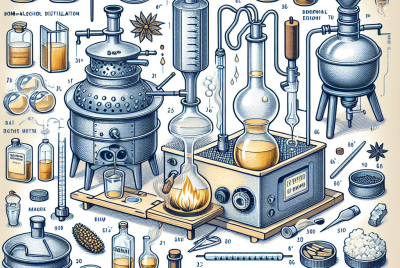How to Get Started with Home Brewing
Introduction
As an enthusiast and avid home brewer, I am excited to share my knowledge and experience on how to get started with home brewing. Brewing your own beer is a fulfilling and rewarding hobby, allowing you to craft unique flavors and share your creations with friends and family (if they’re lucky!). In this article, I’ll guide you through the essential steps and provide some guidance for beginners who are eager to embark on their home brewing journey.
The Joy of Home Brewing
What is Home Brewing?
Home brewing is the process of brewing beer on a small scale, typically done in the comfort of your own home. It gives you the freedom to experiment with different ingredients, flavors, and brewing techniques, resulting in a beer that suits your personal taste preferences.
Benefits of Home Brewing
There are several benefits to home brewing that make it an appealing hobby for beer enthusiasts. Firstly, it allows you to have complete control over the brewing process, from selecting the ingredients to adjusting the alcohol content. Secondly, home brewing is a cost-effective way to enjoy quality beer, as brewing your own can be significantly cheaper than buying commercial options. Lastly, home brewing provides a sense of satisfaction and creativity, as you witness your beer come to life from start to finish.
Getting Started
Before you dive into the world of home brewing, it’s important to familiarize yourself with the essential equipment and ingredients necessary for the process. Let’s explore what you’ll need to begin your brewing adventure.
Essential Equipment for Home Brewing
To get started with home brewing, you’ll need the following equipment:
Brewing Vessel
A brewing vessel, such as a fermenting bucket or glass carboy, is essential for primary fermentation. It provides a controlled environment for yeast to convert sugars into alcohol.
Airlock and Stopper
An airlock and stopper are used to seal the brewing vessel and allow carbon dioxide to escape during fermentation while preventing oxygen or contaminants from entering.
Thermometer
A thermometer is crucial for monitoring and controlling the temperature during brewing and fermentation. Yeast activity and flavors can vary depending on the temperature, so maintaining the right range is important.
Hydrometer
A hydrometer is used to measure the specific gravity of your beer at different stages. It helps you determine the alcohol content and track the progress of fermentation.
Brewing Ingredients
You’ll need a variety of brewing ingredients, including malt extracts, hops, yeast, and specialty grains. These ingredients contribute to the flavor, aroma, and character of your beer.
Choosing Your First Home Brew Kit
To make the process easier for beginners, home brew kits are available that provide all the necessary equipment and ingredients in one package. Here are a few options to consider:
Extract Brewing Kits
Extract brewing kits are ideal for beginners as they simplify the brewing process. These kits include malt extract, which has already undergone the mashing process, making it easier to brew without the need for advanced equipment.
All-Grain Brewing Kits
For those seeking a more authentic brewing experience, all-grain brewing kits are a great option. These kits require more equipment and involve the mashing process, where you extract fermentable sugars from crushed grains.
Starter Kits for Beginners
Starter kits are specifically designed for beginners and often include detailed instructions and recipes. These kits typically come with a brewing vessel, airlock, thermometer, hydrometer, and ingredients to brew your first batch.
Step-by-Step Guide to Brewing Your First Batch
Now that you have your equipment and kit ready, it’s time to start brewing your first batch of beer. Follow this step-by-step guide to ensure a successful brewing process:
Sanitization
Before you begin, ensure that all your equipment is thoroughly cleaned and sanitized. Proper sanitization is crucial to prevent contamination and off-flavors in your beer.
Brewing Process
Follow the instructions provided with your home brew kit to heat the water, add malt extract, and bring the mixture to a boil. Then, add hops at different intervals to create the desired bitterness and aroma.
Fermentation
Once the boiling process is complete, cool the mixture and transfer it to the fermentation vessel. Add yeast and seal the vessel with an airlock and stopper. Place the vessel in a cool, dark area and allow fermentation to occur for the recommended duration.
Bottling and Carbonation
After fermentation, transfer the beer into sanitized bottles and add priming sugar to initiate carbonation. Seal the bottles and store them at room temperature for a couple of weeks to allow carbonation to develop.
Tips and Tricks for Successful Home Brewing
To enhance your home brewing experience and improve the quality of your beer, here are some valuable tips and tricks:
Follow Instructions Carefully
Pay close attention to the instructions provided with your home brew kit and follow them diligently. Each step in the brewing process is important, and deviations can affect the final outcome.
Practice Good Sanitization
Maintain a clean and sanitized brewing environment to prevent contamination. Proper sanitization of equipment, bottles, and utensils will ensure that your beer remains free from unwanted bacteria and flavors.
Experiment with Flavors
Once you gain confidence in the brewing process, don’t be afraid to experiment with different flavors. Add specialty grains, additional hops, or unique ingredients to create your own signature brews.
Join Home Brewing Communities
Connect with other home brewers through online forums or local brewing clubs. These communities provide valuable insights, feedback, and support that can help you improve your brewing skills.
Troubleshooting Common Home Brewing Issues
Even the most experienced home brewers encounter challenges along the way. Here are solutions to common issues you may encounter:
Off-Flavors in Beer
Off-flavors can be caused by factors such as improper sanitization, excessive exposure to oxygen, or fermentation at incorrect temperatures. Pay attention to these factors and adjust accordingly.
Inconsistent Carbonation
If your beer is inconsistently carbonated, it may be due to uneven distribution of priming sugar during bottling. Ensure that you mix the priming sugar thoroughly before bottling to achieve consistent carbonation.
Cloudy Beer
Cloudiness in beer can be caused by inadequate settling time during fermentation or incomplete removal of sediment. Give your beer ample time to settle and consider using fining agents or filtering methods to clarify it.
Conclusion
Congratulations! You’re now equipped with the knowledge and guidance to start your home brewing journey. Remember, practice makes perfect, and with each batch, you’ll gain valuable experience and refine your brewing skills. Enjoy the process, embrace creativity, and savor the satisfaction of brewing your own delicious beers.
Frequently Asked Questions (FAQs)
1: Is home brewing legal?
Yes, home brewing is legal in many countries, including the United States, as long as it is for personal consumption and not for sale.
2: How long does it take to brew beer at home?
The brewing process can take approximately 2 to 6 weeks, depending on the recipe and fermentation time.
3: Can I customize the flavor of my beer?
Absolutely! Home brewing allows you to experiment with different ingredients, flavors, and brewing techniques, giving you the freedom to create unique and personalized beers.
4: How much does it cost to start home brewing?
The cost of starting home brewing can vary depending on the equipment and ingredients you choose. Beginner kits are available at affordable prices, and as you progress, you can invest in more advanced equipment.
5: Can I reuse brewing equipment?
Yes, brewing equipment can be reused multiple times with proper cleaning and sanitization. It’s essential to maintain hygiene to prevent any contamination in future batches.




